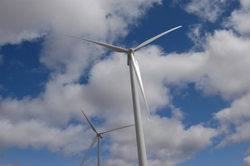Wind Power Overview
Audubon's Position on Wind Power
Summary
Audubon strongly supports properly sited wind power as a renewable energy source that helps reduce the threat posed to birds and people by climate change. However, we also advocate that wind power facilities should be planned, sited, and operated in ways that minimize harm to birds and other wildlife, and we advocate that wildlife agencies should ensure strong enforcement of the laws that protect birds and other wildlife.
Audubon has testified in Congress about the effects of wind turbines on birds and bats. Audubon also supported and helped develop guidelines for the wind industry to help minimize harm to birds and other wildlife. Of course, in order for those guidelines to be effective, the government must enforce existing laws that protect birds and other wildlife. Audubon is a forceful advocate for enforcement of those protective laws, which is why as of December 2013, we are standing in strong opposition to a new U.S. Interior Department rule that will offer 30-year permits for wind farms to kill and injure Bald and Golden eagles.
Finally, Audubon state offices and chapters are active on the local level advocating for meaningful changes to wind development projects to minimize impacts to birds and habitat. Audubon uses cutting-edge mapping technology to visualize potential impacts and advocate for beneficial siting of wind power.
Why Does Audubon Support Properly Sited Wind Power?
Top scientific experts from around the world, including Audubon's own scientists, agree that the effects of climate change are here now and will get worse.[1] Scientists have found that climate change has already affected half of the world's species' breeding, distribution, abundance, and survival rates.[2] The Intergovernmental Panel on Climate Change predicts that by mid-century, climate change may contribute to the extinction of 20-30 percent of all species on earth.
Scientists also agree that in order to help prevent species extinctions and other catastrophic effects of climate change, we must significantly reduce pollution from fossil fuels as quickly as possible. This will require rapidly expanding energy efficiency, renewable energy, and alternative fuels and making changes in land use, agriculture, and transportation.
Properly sited wind power is an important part of the strategy to combat climate change. Wind power is currently the most economically competitive form of renewable energy. As of October 2013, it provides more than 60,000 megawatts of power in the United States. With the current transmission infrastructure, the Department of Energy estimates that wind has the potential to generate 20 percent of the nation's energy.[3] Every megawatt-hour produced by wind energy avoids an average of 1,220 pounds of carbon dioxide emissions. If the United States obtains 20 percent of its electricity from wind power by 2020, it will reduce greenhouse gas emissions equivalent to taking 71 million cars off the road or planting 104 million acres of trees. Expanding wind power instead of fossil fuels also avoids the wildlife and human health impacts of oil and gas drilling, coal mining, and burning fossil fuels.
What's the Risk to Birds and Other Wildlife?
Wind power facilities can harm birds through direct collisions with turbines and other structures, including power lines. Wind power facilities can also degrade or destroy habitat, cause disturbance and displacement, and disrupt important ecological links.
How Should We Protect Birds and Other Wildlife?
Audubon strongly supports wind power and recognizes that it will not be without some impact; however, harmful effects to birds and other wildlife can be avoided or significantly reduced in the following ways:
- Proper siting and operation of wind farms and equipment;
- Development of new technologies that help minimize harm to birds and other wildlife;
- Mitigation of habitat and wildlife impacts through conservation measures;
- Strong enforcement of existing laws that protect wildlife, including the Endangered Species Act, the Bald and Golden Eagle Protection Act, and the Migratory Bird Treaty Act.
Audubon encourages wind developers and permitting agencies to consult with wildlife experts, including Audubon staff and chapters, to help inform study and siting decisions.
References
[1] Climate Change 2007: Impacts, Adaptation and Vulnerability, published on April 6, 2007, by the Intergovernmental Panel on Climate Change at http://www.ipcc.ch. People from over 130 countries contributed to the IPCC Fourth Assessment Report over the previous 6 years. These people included more than 2,500 scientific expert reviewers, more than 800 contributing authors, and more than 450 lead authors.
[2] Camille Parmesan and Gary Yohe, University of Texas at Austin, as cited in the November-December 2007 issue of Audubon magazine.











 Donate Now for your FREE Birding Journal
Donate Now for your FREE Birding Journal Become a Member of Audubon Today
Become a Member of Audubon Today No More Killer Buildings!
No More Killer Buildings! Audubon 2015 Calendars
Audubon 2015 Calendars 